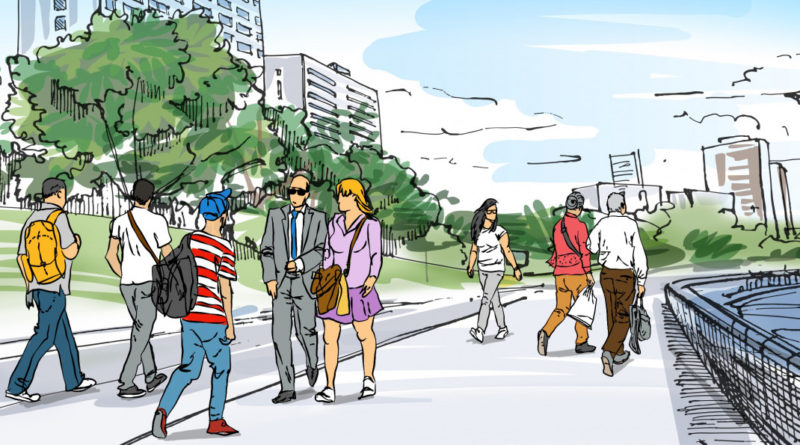LIFE+STYLE | Why do we prefer to walk in shopping malls and not on the street?
.
For Indonesians and other people living in tropical countries, walking in air-conditioned shopping malls is more comfortable than walking outdoors in the heat. But there has been an increase in shopping malls with large outdoor spaces in the Greater Jakarta area, such as Cilandak Town Square (The Breeze), Central Park Mall, Bintaro Xchange and the latest, Ashta District 8 and Sarinah. So, what makes shopping malls more walkable than city streets?
The interior of most shopping malls is, ironically, designed around a utopian city image based on active (non-motorized) mobility. When people of any age can meet everyday needs such as open space, healthcare, education and public transportation simply by walking, it creates a feeling of safety and comfort. Walking in a shopping mall is also less stressful than walking outdoors, even if you walk more than 1 or 2 kilometers daily (the average Jakartan’s willingness to walk maxes out around 300 or 400 meters). In an urban mobility context, some areas, known as pedestrian zones, mimic shopping malls; a pedestrianized street is designed to give pedestrians priority and is an effective way to endorse non-motorized transport (NMT). When implementing road sets with many retail shops, making a pedestrianized street also improves convenience, generates more pedestrian volume and, eventually, leads to increased economic activities inside the pedestrian zone by allowing space for registered street vendors, according to an Institute for Transportation and Development Policy (ITDP) report from 2015.
In Indonesia, the pedestrianization concept is still unfamiliar even though the people and the government unknowingly or accidentally implement the basics of pedestrianization. Nighttime festivals in several cities that block off a street or a certain area are a simple form of pedestrianization. For example, every Friday from 6 p.m. to 12 a.m., motorized vehicles are prohibited from entering a street called Gang Warung in Semarang’s Chinatown because of the famous Semawis Night Market. More permanently, Malioboro Street in Yogyakarta is already famous for its own history as a must-visit tourist destination. Since 2000, several attempts to pedestrianize the road have been made. In 2019, officials decided to close the road to motorized vehicles daily from 6 p.m. to midnight. In Jakarta, there are at least two areas with pedestrianization concepts. Can you guess what they are?
The first one is Kota Tua. On top of claiming to be a low-emission zone (LEZ), Kota Tua is also considered a pedestrianized area. In February 2020, the city of Jakarta began the trial to close six roads surrounding Kota Tua, including Jl. Pintu Besar Utara, Jl. Kali Besar Barat sisi selatan, Jl. Kunir sisi selatan, Jl. Kemukus, Jl. Ketumbar and Jl. Lada. Six roads were closed for regular motorized vehicle access except Transjakarta buses and vehicles with stickers. This new pedestrianization effort added 5 hectares, creating a total 14 hectares limited to pedestrian, cycling and Transjakarta bus use. Even so, traffic data taken on June 29, 2022, by ITDP showed that traffic in Kota Tua, especially in areas where Transjakarta buses should only be allowed, was still dominated by motorbikes, which constituted more than 60 per cent of traffic in the area.
Before Kota Tua, there was Terowongan Kendal. The conversion of Kendal Street into a vibrant and safe pedestrian tunnel allowed 5,000 pedestrians per hour to transfer between intercity trains, the MRT, airport trains and the Transjakarta BRT. This project required a collaborative approach that was led by the city and involved local street artists who embellished the tunnel. The pedestrian tunnel became a new space for cultural, social and economic activities.
Jakarta newest upcoming hip area is the extension of Terowongan Kendal. As a transfer location, continuing the pedestrianized Kendal Tunnel will be a big win because it will increase accessibility and create another open public space. The area that will be closed includes Jl. Blora-Kendal, creating a 1,500-meter square pedestrianization area.
The success of prior interventions should be continued and scaled up with an additional set of interventions or policies. The pedestrianized streets should be followed up with a policy to limit the usage of private motorized vehicles and a set of regulations to monitor the impact. Such pedestrian streets should be designed with more active frontage and other human-oriented design aspects, like awnings to provide shade. Involving the local people in the planning, implementation and monitoring of the processes is key to success. It will let people have a high sense of belonging to the area. Finally, further planning should be drafted on a city scale as a roadmap so impacts can be measured and monitored.
As each intervention and transformation of the pedestrianization concept in Jakarta has been largely successful, the city should continue to expand this concept. Jakarta should also be consistent with banning individual motorized vehicles from entering pedestrian areas to ensure their success. As we learned from the Kota Tua case, which was protested by locals because the policy impacted their access to different services and transportation options, constant dialogue and discussion is needed.
— Have a question about urban transportation? Send it to [email protected] with your name and current location (anonymous submissions will also be considered). Please note that The Jakarta Post reserves the right to edit your letters for publication
***
Work It Right is a weekly column that provides practical and insightful advice on the complexities of urban transportation.
The author is a senior communications and partnership manager at the Institute for Transportation and Development Policy (ITDP).


 Memento Maxima Digital Marketing
Memento Maxima Digital Marketing







